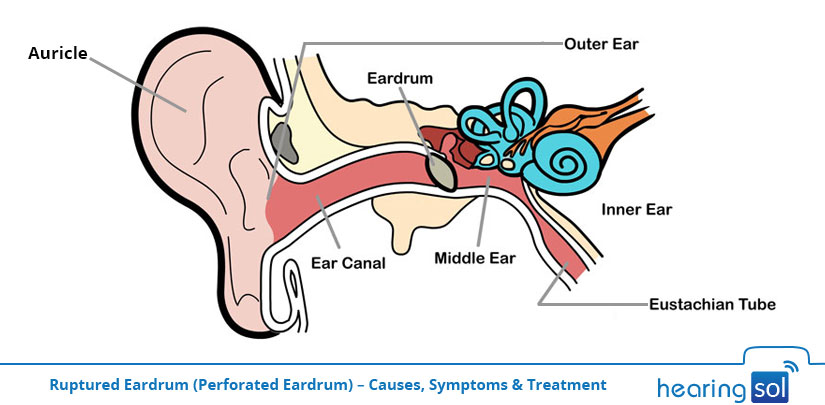
Our ears are our vital organs and they are sensitive, too. Like any other part of our body, problems may occur with our ears as well. One of the major ear problems which should be taken into account is the ruptured eardrum.
Eardrum plays a vital role in hearing. If it will be ruptured or damaged, it will adversely affect your hearing ability. Well before addressing the problem of a ruptured or perforated eardrum.
Let’s begin with a brief look at the eardrum and its function.
You can purchase the latest hearing aids at a fair price through HearingSol, If you need any assistance or you have a query regarding Ruptured Eardrum or Hearing Loss, feel free to call us at +91-9327901950. We are always here to help you.
What is Eardrum?
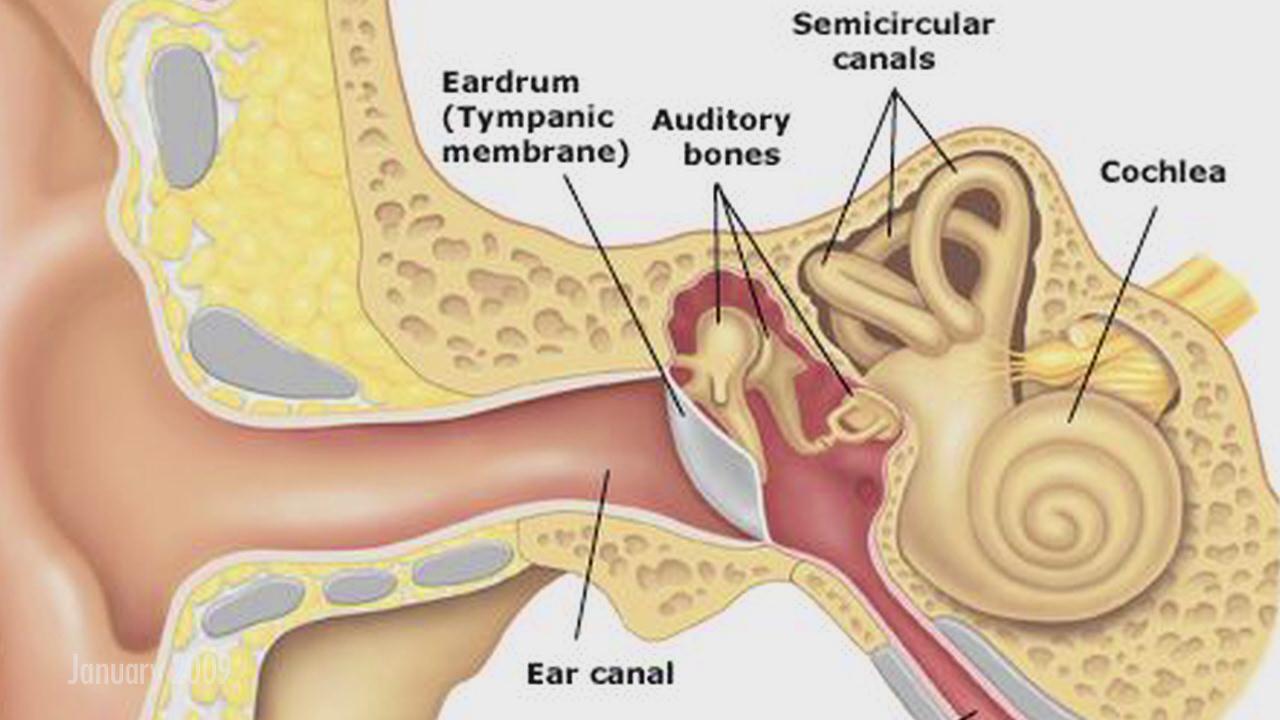
The eardrum is a thin, cone-shaped membrane that separates the external ear from the middle ear. Your eardrum looks like a drum. It performs dual functions:
- Hearing – It senses vibrating sound waves and converts the vibration into nerve impulses that convey the sound to your brain.
- Protection – It also protects the middle ear from bacteria as well as water and foreign objects.
Thus eardrum seems to be a very vital part of your auditory system. Damage to an eardrum destroys the whole functioning of the auditory system and may lead to hearing-related problems. What damages the eardrum and how it affects your hearing?
Let’s discuss these in the upcoming sections.
What Is Ruptured or Perforated Eardrum?
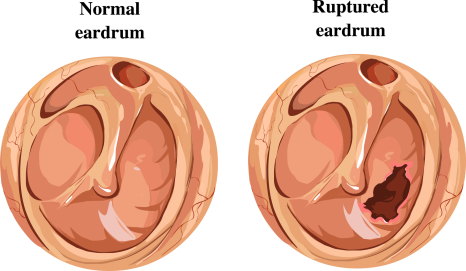
In medical terms, the eardrum damage is generally known as “tympanic membrane” ruptured or perforated eardrum by professional medical practitioners.
A ruptured eardrum is just like a clap of hands happen suddenly. You may or may not observe symptoms. Rupture or perforation of eardrum leads to conductive hearing loss.
The perforated or ruptured eardrum is actually a tear or hole in the eardrum may create uneasiness and sometimes, may even lead to complications like mild to intense pain in the affected ear, or cause loss of hearing at later stages.
How does the eardrum rupture? Well, this question is very important to know the underlying cause behind your ruptured eardrum.
A ruptured eardrum, also known as a perforated eardrum has its own set of causes and symptoms. We shall look at these in the following sections.
Causes of Ruptured Eardrum
There can be a lot of factors that are responsible for causing a ruptured eardrum in a person, either directly or indirectly.
But the most important causes of the ruptured eardrum are ear infections, insertion of foreign objects, head injury, change in pressure, loud sounds, etc.
Let’s discuss each of the causes of the ruptured eardrum in detail:
1. Infection In The Ear
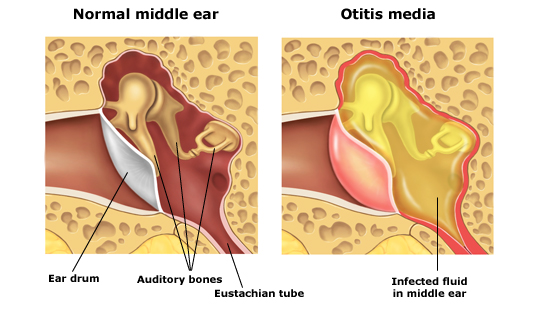
Middle ear infection leads the pressure to build up and pushes against the eardrum. When the pressure increases, the eardrum may perforate. You may suddenly notice that the pain and pressure you’ve felt from the infection suddenly stops and pus drains from the ear.
2. Poking Objects Inside the Ear
When you insert sharp objects, cotton swab, pointed objects to clear the earwax, it causes perforation of the eardrum. Sometimes children insert small toys, or pointed objects and damage their eardrum.
The deep insertion of foreign objects can damage the inner ear structure as well as eardrum damage.
3. Acoustic Trauma
Head injuries caused by a car accident, injuries due to sports, falling or hitting on your ears, etc pose a high risk of a perforated eardrum.
Head trauma or ear slap may cause perforation of the eardrum. Severe injury, such as skull fracture, may cause the dislocation or damage to middle and inner ear structures, including your eardrum.
4. Air Pressure
Some ruptured eardrums may be the result of Air Barotrauma. This happens when the pressure in the ear and outside the ear is not equal, it may lead to a ruptured eardrum. For Example, during air flight altitude changes. Scuba diving and a direct blow to the ear, such as the impact of an automobile airbag can lead to a perforated eardrum.
5. Loud sounds
The audible limit of your ears is 85 decibels. The sounds exceeding this limit may lead to a perforated eardrum. Loud sounds like blasts, an explosion of the gun, noises from music, construction work, etc or overpowering sound can cause a tear of the eardrum.
People are generally not aware that there are certain things and/or events that may pose an impact on the ears, either directly or indirectly, thereby, leading to the cause of such problems.
How will you come to know if your eardrum is punctured? Though some of them may not experience any signs, their eardrum has been damaged.
Normally you will observe the signs of your eardrum damage due to certain abnormalities of your ear.
Symptoms of Perforated Eardrums
Some people are unable to tell whether they have a ruptured eardrum or not. As they don’t notice any symptoms of a ruptured eardrum.
But some of them immediately visit the audiologists after concluding that something is wrong with their eardrum. They may start to hear air coming out of the ear. Normal sounds seem to be louder for the sufferers.
When a person has a ruptured eardrum, he or she will start displaying certain signs which can make them feel complications in their hearing as well as in their ears. These complications can occur either once or frequently on a single day.
Common symptoms of a ruptured eardrum are given as follows:
- Cold and fever
- Nasal congestion
- Inflammation in the middle ear
- Pus or fluid-filled inside the ear
- Temporary pain in the ear
- Infection in the ear
- Blood draining out from the ear
- Wheezing sound
- Ringing in the ear (aka tinnitus)
- Spinning sensation (aka vertigo)
- Whistling sound when sneezing or blowing your nose
- Vertigo resulting in nausea or vomiting
- Pain in the ear that subsides quickly
- Difficulty in hearing or hearing loss (temporary or partially)
- Facial weakness or dizziness
Having complications is similar to the moment of having terrible nightmares that makes you feel uneasy and perhaps, unhappy.
Persons who usually show any or all of these symptoms, then proper treatment becomes necessary in order to heal the condition effectively and preserve your hearing.
If the above symptoms are disturbing you, immediately visit your nearby hearing care center for further treatment of ruptured or perforated eardrum.
Diagnosis of Ruptured Eardrum (Tympanic Membrane)
During the initial stages, the natural healing of a ruptured eardrum usually takes a few weeks without having to undergo any kind of medical treatment at a healthcare institution.
However, if the symptoms do not heal by itself over time and the pain tends to increase, then immediate treatment is essential in order to heal a ruptured eardrum, or at least reduce its intensity so that the person may be able to live his or her life normally again.
Perforated Eardrum Diagnosis
A prompt diagnosis is required from a doctor or ENT specialist to check whether or not the eardrum is affected, followed by the necessary tests to determine the degree of the damage if found any.
Generally, if doctors or ENT specialists find problems in the ear, such as a ruptured eardrum, additional tests are carried out for diagnosis and treatment. Some of the common tests include:
1. Otoscopic Exam
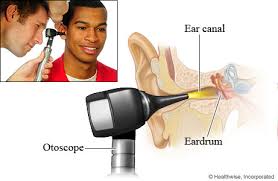
An otoscope is an instrument with a light that’s used to look inside the ear. With the help of this instrument, a doctor can see a tear or hole in the eardrum. It is a general and common diagnostic hearing device.
2. Laboratory Tests
In this test, if there is a discharge of fluid or blood from your ear, the doctor carefully checks the middle ear to detect a possible bacterial infection that may have caused the discharge and subsequently heal the condition.
3. Tympanometry
The tympanum is the main cavity of the ear, that is, between the eardrum and the inner ear. Thus, with the help of a tympanometer, which is a device used in the process of tympanometry, an ENT specialist can read the changes in the patterns of response of your eardrum to the slightest changes in the air pressure and detect a perforated eardrum.
4. Tuning Fork Evaluation
Doctors use the tuning fork evaluation (use of metal tuning forks instrument to produce sounds when struck) approach to detect hearing loss in individuals of any age group, which may have been caused by damage to the vibrating parts of the person’s middle ear and the eardrum, damage to sensors or nerves of your inner ear, or even damage to both.
5. Audiology Exam
Another effective method of the treatment of a ruptured or perforated eardrum is the audiology examination. This includes a series of calibrated audio tests that are conducted in a soundproof space to measure the hearing ability of the person at different volumes and pitches.
Treatment of Ruptured Eardrum
Well, there is no specific treatment for the ruptured eardrum. As most of the ruptured eardrums take three months to heal. But you should immediately consult an audiologist if the situation is worsening.
1. Patching
If your ear does not heal on its own, your doctor may patch the eardrum. Patching involves placing a medicated paper patch over the tear in the membrane. The patch encourages the membrane to grow back together.
2. Medications
Your doctor may prescribe antibiotics in the form of oral or ear drops to treat the infections leading to eardrum damage. If you are suffering from the pain, you may prefer over the counter pain medications like acetaminophen or ibuprofen.
3. Surgery
Depending on the severity of your ear condition, a professional doctor may advise you to undergo surgery, which may be the best solution to heal the eardrum.
The surgery is usually done on an outpatient basis. During the procedure, which usually takes a couple of hours, the doctor will attach a piece of your own tissue to the eardrum to rebuild the eardrum.
This surgical repair of a perforated eardrum is known as a tympanoplasty.
Post-Treatment Care
- Take the medicines advised by your audiologist.
- Avoid medicines that are not advised by your doctors.
- Protect the ear from cold air.
- Avoid blowing your nose while the ear heals.
- Protect your ears from water till eardrum heals.
You’ll usually be able to leave the hospital within one to two days of an eardrum surgery. Full recovery, especially after treatment or surgical procedures, typically occurs within eight weeks.
Ruptured Eardrum In Children
Eardrum ruptures can happen much more frequently in children because of their sensitive tissue and narrow ear canals.
Children have the habit of inserting pointed objects, their toys, pointed nails in the ears. As a result, unintentionally, they damage their eardrum.
The most common cause of ruptured eardrums in children is ear infections. 5 out of 6 children have at least one ear infection by the time they’re 3 years old.
Your child’s risk of infection can be higher if they spend time in a group daycare or if they bottle-feed while lying down instead of breastfeeding.
Take your child to an ENT specialist if you observe the signs of a ruptured eardrum. As it needs additional care. Avoid flying with your child if he has sinus, sinus headache, or cold infections.
Your child’s eardrums are delicate, untreated damage can have long-term effects on their hearing.
Learn How You Can Prevent Rupturing Eardrum
You can prevent rupturing your eardrum by taking effective precautions and save yourself from the trouble of getting your ears damaged.
In addition to this, taking note of the following measures or home remedies can also help you prevent your ears from the ill-effects.
- Avoid inserting sharp objects inside the ear.
- Be aware of the signs and symptoms of middle ear infections.
- Always keep your ears dry before and after bathing, showering, swimming, etc.
- Do not use cotton swabs for cleaning the build-up ear wax.
- Protect your ears during flight.
- Use earplugs, yawn, or chew gums when experiencing air pressure.
- Avoid loud sounds and noises if you are sensitive to sounds and use hearing protective devices.
- Do not blow your nose too hard.
- Apply ear-drops for cleaning or when having mild pain in the ear.
- Consult your doctor if you face the abnormalities in your hearing and other signs of a ruptured eardrum.
Outlook
The eardrum is an essential part of your ear. Thus it should be prevented from perforation or damage. In case you are unsure or doubt that you may have certain signs and symptoms that are common to a ruptured eardrum, then it is advised that you see a doctor or an ENT specialist at a nearby healthcare institution.
Eardrum needs additional care in both the pretreatment period as well as post-treatment period. Guide yourself with the preventive strategies, signs, and symptoms and be aware of your ears in order to prevent rupturing eardrum.
You can purchase the latest hearing aids at a fair price through HearingSol, If you need any assistance or you have a query regarding Ruptured Eardrum or Hearing Loss, feel free to call us at +91-9327901950. We are always here to help you.

 Reviewed by Mr. Ranjeet Kumar
Sr. Audiologist, Speech Therapist & Cochlear Implant Specialist, BASLP on
Reviewed by Mr. Ranjeet Kumar
Sr. Audiologist, Speech Therapist & Cochlear Implant Specialist, BASLP on